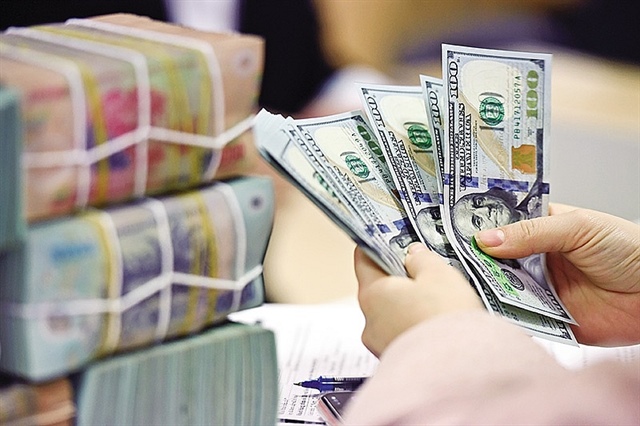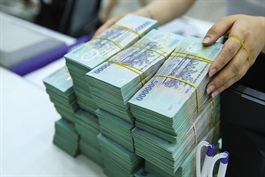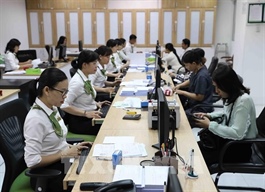Fed rate cut offers Vietnam room to stabilise currency and economy
Fed rate cut offers Vietnam room to stabilise currency and economy
The US Federal Reserve’s first rate cut of 2025 is easing borrowing costs and offering Vietnam room to stabilise its currency and economy.
On September 17, the Fed lowered its benchmark interest rate by 25 basis points to 4.00–4.25 per cent, the first reduction this year, helping to relieve mounting pressure on the USD/VND exchange rate and support Vietnam’s macroeconomic stability.
On the same day, the VND continued to strengthen, with the State Bank of Vietnam (SBV) setting the central rate at VND25,186 per USD, down VND12 from the previous session. This marked the tenth consecutive session without an uptick since the peak of VND25,248 per USD on September 4.
Assoc. Prof., Dr Tran Hoang Ngan, National Assembly delegate and economist, described the Fed’s decision as a positive signal for Vietnam’s economy.
"The Fed’s rate cut will ease pressure on the exchange rate from now until the end of the year. This will help stabilise the macroeconomy and lower interest rates on the VND in the coming months, supporting businesses in borrowing capital and expanding production during the final quarter," he said.
Analysing four key transmission channels of the Fed’s move for Vietnam, Assoc. Prof. Dr. Dinh Trong Thinh, former head of International Finance Department at Academy of Finance, said, "Lower US interest rates will stimulate domestic consumption and investment, thereby boosting demand for imports, which benefits Vietnam’s exports."
"Second, a weaker dollar reduces the USD/VND exchange rate pressure, easing import costs. Third, borrowing and investment costs in foreign currency for both Vietnamese firms and the government will fall significantly," he added. "And fourth, the stock market and foreign portfolio inflows will gain momentum as cheaper global capital flows into emerging markets such as Vietnam."
|
In its Vietnam Economic Growth Forecast for Q4/2025, released on September 17, UOB’s Global Economics and Market Research noted that, unlike many regional peers, the VND weakened to a record low of 26,436 per USD in August, a 3.4 per cent year-to-date decline and the fourth consecutive year of depreciation.
“Although Vietnam secured a trade deal with the US that cut tariff rates to 20 per cent from the 46 per cent announced in April, uncertainty over a potential 40 per cent transshipment tariff may prompt firms to reassess supply chains, reducing Vietnam’s appeal for foreign investment,” the report said.
Looking ahead, UOB expects the VND to lag regional currencies despite renewed USD softness as the Fed begins its rate-cutting cycle, projecting USD/VND at 26,300 in Q4 2025, easing to 26,200 in Q1 2026, 26,100 in Q2, and 26,000 in Q3.
"Combined with robust growth prospects in the second half of 2025 and persistent VND weakness, these factors are likely to constrain the SBV’s ability to ease monetary policy. The refinancing rate is expected to remain steady at 4.5 per cent. Only in the case of a sharp downturn in business activity or labour markets would the central bank consider a one-off cut to the pandemic low of 4 per cent, though this is not our base case," added UOB.
Recent exchange rate pressures have limited room for further cuts in deposit and lending rates. At the same time, rising credit demand, particularly during the year-end business peak, has prompted banks to step up mobilisation, making it difficult to keep funding costs low.
Nguyen Quang Huy, CEO of the Finance and Banking Faculty at Nguyen Trai University, argued that the Fed’s 25-basis-point cut could mark the beginning of a broader global monetary easing cycle.
"This is not merely a technical adjustment; it signals that the cost of international capital is entering a softer phase. For emerging markets like Vietnam, this presents a crucial window of opportunity to stabilise the exchange rate and expand growth potential," he said.
According to Huy, lower Fed rates reduce the pressure to maintain high domestic rates, allowing commercial banks to cut borrowing costs. Greater liquidity would also strengthen the banking system and encourage credit expansion. However, he cautioned that the benefits of cheaper capital would only be sustainable if tied to macroeconomic stability.
"As borrowing costs decline, both businesses and households are likely to expand loans for production, investment, and consumption. This supports exports while stimulating real estate, infrastructure, and domestic consumption," said Huy.
"The Fed has opened a 'cheap capital window' for emerging economies. Whether Vietnam can turn this opportunity into sustainable growth depends on how effectively it directs credit flows and coordinates fiscal, monetary, and institutional policies. Crucially, capital must be channelled into production, technological innovation, and long-term growth sectors, rather than excessive short-term speculation," he added.
MBS Research's money report published on September 12 projected that deposit rates would come under pressure from rising credit growth towards the year-end, especially after the SBV’s recent announcement of higher credit growth quotas for banks to meet economic funding needs.
"Deposit rates have been kept stable thanks to ample liquidity following large net injections by the SBV in June and July. This has, in turn, allowed banks to maintain relatively low lending rates in line with government directives to support economic growth," stated in the report.
MBS Research forecasted that the average 12-month deposit rate among private joint-stock commercial banks could ease slightly by 0.02 percentage points to 4.7 per cent by end-2025.
- 18:50 19/09/2025





























